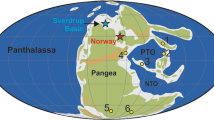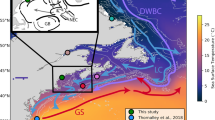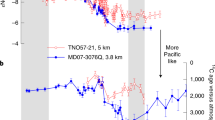Abstract
Chemical weathering of the continents is central to the regulation of atmospheric carbon dioxide concentrations, and hence global climate1,2. On million-year timescales silicate weathering leads to the draw-down of carbon dioxide1, and on millennial timescales chemical weathering affects the calcium carbonate saturation state of the oceans and hence their uptake of carbon dioxide2. However, variations in chemical weathering rates over glacial–interglacial cycles remain uncertain. During glacial periods, cold and dry conditions reduce the rate of chemical weathering3, but intense physical weathering3,4 and the exposure of carbonates on continental shelves due to low sea levels5,6 may increase this rate. Here we present high-resolution records of the lead isotope composition of ferromanganese crusts from the North Atlantic Ocean that cover the past 550,000 years. Combining these records with a simple quantitative model of changes in the lead isotope composition of the deep North Atlantic Ocean in response to chemical weathering, we find that chemical weathering rates were two to three times lower in the glaciated interior of the North Atlantic Region during glacial periods than during the intervening interglacial periods. This decrease roughly balances the increase in chemical weathering caused by the exposure of continental shelves, indicating that chemical weathering rates remained relatively constant on glacial–interglacial timescales. On timescales of more than a million years, however, we suggest that enhanced weathering of silicate glacial sediments during interglacial periods results in a net draw-down of atmospheric carbon dioxide, creating a positive feedback on global climate that, once initiated, promotes cooling and further glaciation.
This is a preview of subscription content, access via your institution
Access options
Subscribe to this journal
Receive 51 print issues and online access
$199.00 per year
only $3.90 per issue
Buy this article
- Purchase on Springer Link
- Instant access to full article PDF
Prices may be subject to local taxes which are calculated during checkout



Similar content being viewed by others
References
Raymo, M. E., Ruddiman, W. F. & Froelich, P. N. Influence of late Cenozoic mountain building on ocean geochemical cycles. Geology 16, 649–653 (1988)
Archer, D., Winguth, A., Lea, D. W. & Mahowald, N. What caused the glacial/interglacial atmospheric pCO2 cylces?. Rev. Geophys. 38, 159–189 (2000)
Riebe, C. S., Kirchner, J. W. & Finkel, R. C. Erosional and climatic effects on long-term chemical weathering rates in granitic landscapes spanning diverse climate regimes. Earth Planet. Sci. Lett. 224, 547–562 (2004)
Taylor, A. & Blum, J. D. Relation between soil age and silicate weathering rates determined from chemical evolution of a glacial chronosequence. Geology 23, 979–982 (1995)
Gibbs, M. T. & Kump, L. R. Global chemical erosion during the last glacial maximum and the present: Sensitivity to changes in lithology and hydrology. Paleoceanography 9, 529–543 (1994)
Jones, I. W., Munhoven, G., Tranter, M., Huybrechts, P. & Sharp, M. J. Modelled glacial and non-glacial HCO3-, Si and Ge fluxes since the LGM: little potential for impact on atmospheric CO2 concentrations and a potential proxy of continental chemical erosion, the marine Ge/Si ratio. Global Planet. Change 33, 139–153 (2002)
Henderson, G. M. & Maier-Reimer, E. Advection and removal of 210Pb and stable Pb isotopes in the oceans: A general circulation model study. Geochim. Cosmochim. Acta 66, 257–272 (2002)
Frank, M. Radiogenic isotopes: tracers of past ocean circulation and erosional input. Rev. Geophys. 40 doi: 10.1029/2000RG000094 (2002)
Dickson, R. R. & Brown, J. The production of North Atlantic Deep Water: Sources, rates and pathways. J. Geophys. Res. 99, 12319–12341 (1994)
Foster, G. L., Vance, D. & Prytulak, J. No change in the neodymium isotope composition of deep water exported from the North Atlantic on glacial–interglacial timescales. Geology (in the press).
Piepgras, D. J. & Wasserburg, G. J. Rare-earth element transport in the Western North-Atlantic inferred from Nd isotopic observations. Geochim. Cosmochim. Acta 51, 1257–1271 (1987)
Harlavan, Y., Erel, Y. & Blum, J. D. Systematic changes in lead isotopic composition with soil age in glacial granitic terrains. Geochim. Cosmochim. Acta 62, 33–46 (1998)
Erel, Y. & Morgan, J. J. The relationship between rock-derived lead and iron in natural waters. Geochim. Cosmochim. Acta 56, 4157–4167 (1992)
Harlavan, Y. & Erel, Y. The release of Pb and REE from granitoids by the dissolution of accessory phases. Geochim. Cosmochim. Acta 66, 837–848 (2002)
von Blanckenburg, F. & Nägler, T. F. Weathering versus circulation-controlled changes in radiogenic isotope tracer composition of the Labrador Sea and Northern Atlantic Deep Water. Paleoceanography 16, 424–434 (2001)
Vance, D. & Burton, K. Neodymium isotopes in planktonic foraminifera: a record of the response of continental weathering and ocean circulation rates to climate change. Earth Planet. Sci. Lett. 173, 365–379 (1999)
Reynolds, B. C., Sherlock, S. C., Kelley, S. P. & Burton, K. W. Radiogenic isotope records of Quaternary glaciations: changes in the erosional source and weathering processes. Geology 32, 861–864 (2004)
Blum, J. D. in Tectonic Uplift and Climate Change (ed. Ruddiman, W. F.) 259–288 (Plenum, New York, 1997)
Millot, R., Gaillardet, J., Dupré, B. & Allègre, C. J. The global control of silicate weathering rates and the coupling with physical erosion: new insights from rivers of the Canadian Shield. Earth Planet. Sci. Lett. 196, 83–98 (2002)
Kump, L. R. & Alley, R. B. in Material Fluxes on the Surface of the Earth (eds Usselman, T. M. & Hay, W. W.) 46–60 (National Academy Press, Washington DC, 1994)
Henderson, G. M., Martel, D. J., O’Nions, R. K. & Shackleton, N. J. Evolution of seawater 87Sr/86Sr over the last 400-Ka—the absence of glacial interglacial cycles. Earth Planet. Sci. Lett. 128, 643–651 (1994)
Catubig, N. et al. Global deep-sea burial rate of calcium carbonate during the Last Glacial Maximum. Paleoceanography 13, 691–697 (1998)
Broecker, W. S. et al. Evidence for a reduction in the carbonate ion content of the deep sea during the course of the Holocene. Paleoceanography 14, 744–752 (1999)
Reynolds, B. C., Frank, M. & O’Nions, R. K. Nd- and Pb-isotope time series from Atlantic ferromanganese crusts: implications for changes in provenance and paleocirculation over the last 8 Myr. Earth Planet. Sci. Lett. 173, 381–396 (1999)
Roy, M., Clark, P. U., Raisbeck, G. M. & Yiou, F. Geochemical constraints on the regolith hypothesis for the middle Pleistocene transition. Earth Planet. Sci. Lett. 227, 281–296 (2004)
Imbrie, J. et al. in Milankovitch and Climate (eds Berger, A. L., Imbrie, J., Hays, J., Kukla, G. & Saltzmen, B.) 269–305 (Reidel, Dordrecht, 1984)
Millot, R., Allègre, C. J., Gaillardet, J. & Roy, S. Lead isotopic systematics of major river sediments: a new estimate of the Pb isotopic composition of the Upper Continental Crust. Chem. Geol. 203, 75–90 (2004)
Fagel, N. et al. Nd and Pb isotope signatures of the clay-sized fraction of Labrador Sea sediments during the Holocene: Implications for the inception of the modern deep circulation pattern. Paleoceanography 19 doi: 101029/2003PA000993 (2004)
Farmer, L. G., Barber, D. & Andrews, J. Provenance of Late Quaternary ice-proximal sediments in the North Atlantic: Nd, Sr and Pb isotopic evidence. Earth Planet. Sci. Lett. 209, 227–243 (2003)
Acknowledgements
We thank G. Henderson for providing the crusts analysed in this paper; C. Hawkesworth and T. Elliott for constructive comments on an earlier draft of this manuscript; C. Coath for laboratory assistance; and B. Charlier for help with micro-drilling. Support for this research was provided by a NERC fellowship to G.L.F. and a NERC Joint Infrastructure Fund grant to the Department of Earth Sciences, University of Bristol.
Author information
Authors and Affiliations
Corresponding author
Ethics declarations
Competing interests
Reprints and permissions information is available at www.nature.com/reprints. The authors declare no competing financial interests.
Supplementary information
Supplementary Information
This file contains three sections – Supplementary Methods, Supplementary Figures and Supplementary Tables. The Supplementary Methods section provides additional information regarding the techniques used for the isotopic analysis of Pb in ferromanganese crusts using laser ablation. The Supplementary Figures section contains four images which show the location of the Pb isotope tracks and plots of 206Pb/204Pb and 208Pb/204Pb against age for each crust. The Supplementary Tables section contains three tables detailing the Pb isotopic data for crusts ALV 539, BM1969.05 and TR079 D-14. (PDF 609 kb)
Rights and permissions
About this article
Cite this article
Foster, G., Vance, D. Negligible glacial–interglacial variation in continental chemical weathering rates. Nature 444, 918–921 (2006). https://doi.org/10.1038/nature05365
Received:
Accepted:
Issue Date:
DOI: https://doi.org/10.1038/nature05365
This article is cited by
-
Rapid coupling between solid earth and ice volume during the Quaternary
Scientific Reports (2021)
-
Chance played a role in determining whether Earth stayed habitable
Communications Earth & Environment (2020)
-
Glacial–interglacial Nd isotope variability of North Atlantic Deep Water modulated by North American ice sheet
Nature Communications (2019)
-
Ice sheets matter for the global carbon cycle
Nature Communications (2019)
-
Neodymium isotope evidence for glacial-interglacial variability of deepwater transit time in the Pacific Ocean
Nature Communications (2018)
Comments
By submitting a comment you agree to abide by our Terms and Community Guidelines. If you find something abusive or that does not comply with our terms or guidelines please flag it as inappropriate.



